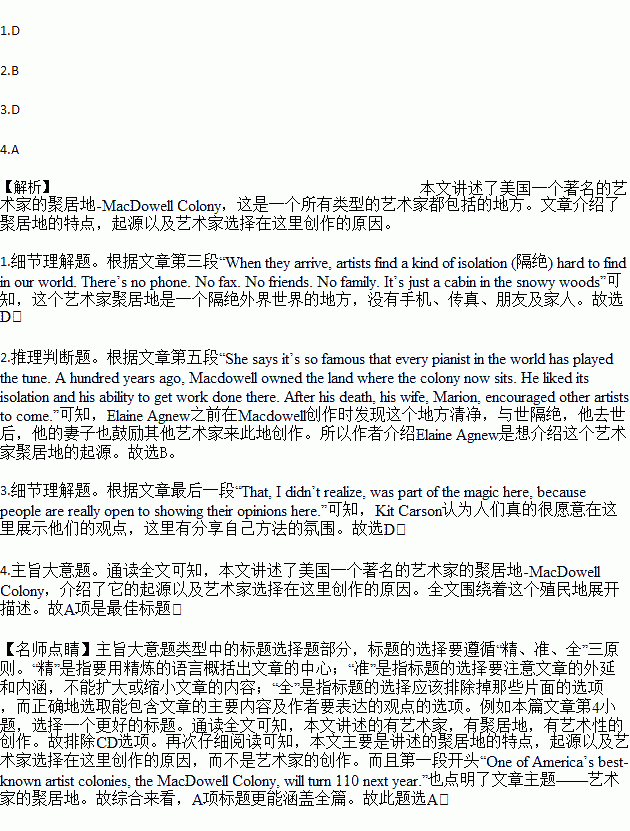题目内容
One of America’s best-known artist colonies, the MacDowell Colony, will turn 110 next year. It is a place where artists of all types can sweep away distractions (令人分心的事物) and just create.
MacDowell’s operations are funded by foundations, corporations and individuals. Writers, composers, photographers, filmmakers and sculptors — both famous and unknown —compete for the 32 free studios at the place. Once accepted, an artist can stay for as little as a couple of weeks, or as long as a couple of months.
When they arrive, artists find a kind of isolation (隔绝) hard to find in our world. There’s no phone. No fax. No friends. No family. It’s just a cabin in the snowy woods.
Writer Emily Raboteau lives in New York City. She came to MacDowell to work on a novel. She received a desk, chairs, pencil and paper — and ice grippers. The walk from one isolated, one-room studio to another is icy, so colony residents (居住的人) fasten the ice grippers to the bottom of their shoes.
Another colony resident, Belfast composer Elaine Agnew, plays a piece called “To a Wild Rose,” written by Edward MacDowell. She says it’s so famous that every pianist in the world has played the tune. A hundred years ago, Macdowell owned the land where the colony now sits. He liked its isolation and his ability to get work done there. After his death, his wife, Marion, encouraged other artists to come.
And for the last century, artists have accepted the invitation, coming to step outside of their daily lives for a short time. Privacy is respected, but cooperation and discussion is common.
Screenwriter Kit Carson — who wrote Texas Chainsaw Massacre 2 and the film adaptation of Sam Shepherd’s play Paris, Texas — has visited MacDowell twice. He says that the interdisciplinary (学科间的) discussion there is valuable.
“You sit around at dinner, talking, and then somebody runs off and brings you back some stuff and shows it to you,” he says. “That, I didn’t realize, was part of the magic here, because people are really open to showing their opinions here.”
1.What do the colony residents have in common?
A. They find it hard to survive the loneliness.
B. They usually stay in the colony for months.
C. They are already famous in their own field.
D. They are nearly cut off from the outside world.
2.Why does the author mention Elaine Agnew?
A. To show the wide range of the residents.
B. To introduce the origin of the colony.
C. To admire her great musical talent.
D. To show respect for MacDowell.
3.Where does the magic of the MacDowell Colony lie according to Kit Carson?
A. It has a homely feel. B. It values work-play balance.
C. It encourages privacy greatly. D. It has an idea-sharing atmosphere.
4.What would be the best title for the text?
A. Wonderland for artists B. Creativity at work
C. Happy birthday! D. Power of silence

